IntMath Newsletter: 3D planes, resources, 200 TB math answer
By Murray Bourne, 28 Jun 2016
28 Jun 2016
In this Newsletter:
1. 3D intersection of planes interactive applet
2. Resources: OER and Galileo
3. Math in the news: 200 TB proof
4. Math puzzles
5. Final thought: hustle hard
τ Day (6/28)
Today is Tau Day, a cheeky response to Pi Day, held in March.
1. Intersection of 3 planes at a point: 3D interactive graph
|
This 3D planes applet allows you to explore the concept of geometrically solving 3 equations in 3 unknowns. Here's some background and a link to the applet. |
2. Resources
(a) Open Educational Resource Commons
This resource is appropriate for both students and teachers.
|
Open Educational Resources provides free text books (in PDF) and other resources in a wide variety of topics (including science, arts & humanities and technical areas.) |
The mathematics section had some neat materials, including articles on estimation, statistics, calculus and trigonometry.
There's also a STEM Literacy section, which states in the welcome:
|
A STEM literate person considers how STEM can improve the social, cultural, economic, and environmental conditions of their local and global communities. |
(b) Galileo: Inquiry-based learning
|
Galileo.org is mostly aimed at teachers, and provides some interesting inquiry-based resources in mathematics and science, including lesson designs and classroom examples. There are also articles and suggestions regarding technology-based approaches to teaching. |
3. Math in the news
Consider a 3,4,5 Pythagorean triple, as follows. We color 2 of the squares red, and the other blue.
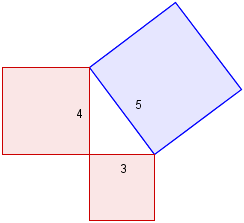
Next, construct a 5,12,13 right triangle based on that blue 5×5 square, as follows.
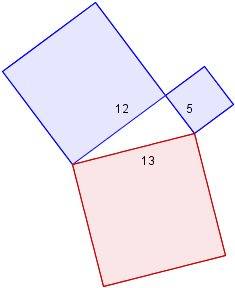
We choose blue and red for the colors of the other two triangles. We could have swapped those 2 colors, but we can't have all blue, or all red.
What we're doing is demonstrating Ronald Graham's Boolean Pythagorean Triples problem, which asks if it's possible to color the squares given by all the Pythagorean triples using exactly two colors only.
With small numbers like the ones above, it seems quite straightforward, but as the numbers get bigger we may be forced to choose a color for one of the triples based on a previous condition, only to find the current set doesn't allow that color (because we may end up with all blue, or all red squares).
Graham offered a $100 prize to anyone who could solve the problem (that is, can it be done for all Pythagorean triples?).
Last month, researchers Marijn Heule from the University of Texas, Victor Marek from the University of Kentucky, and Oliver Kullmann from Swansea University used a Stampede supercomputer to solve it.
The answer is a 200 terabyte file which is not human-readable. It would take you 30,000 hours just to download it!
So is it a proof?
This is a great example of how modern mathematics is becoming irrevocably entwined with computers. There has been some interesting discussion about whether such a large file can be considered a "proof" at all. It can be read by computers and verified by computers, but we humans can't really step through such a proof and check its validity.
Graham was happy with the answer and the researchers got their $100.
More information here:
The world's largest maths problem has been solved, and it takes up 200 TB
4. Math puzzles
The puzzle in the last IntMath Newsletter involved solving an equation with 6 square roots and 6 fractions.
Correct answers with sufficient explanation (which included some reasoning about the number of solutions) were given by: Don, Giorgos, Lidia and Nour. Other partially correct answers (not including the uniqueness part) were given by Cara and Manju.
Nour's approach was to graph it (after substracting the 3 right-hand terms from both sides). He would have seen something like this:
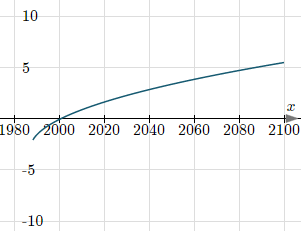
Graphical solution of equation
The graph is discontinuous, since it has no value for x < 1988. It continues on beyond 2100 getting less and less steep, but never crosses the x-axis again. (It looks something like a half-parabola on its side.) So there was a unique solution.
New math puzzle
At a plant stall, I can buy 8 xerophytes for $1, yams for $1 each and zinnias for $10 each. I grab a selection of plants and find at the checkout that I have exactly 100 plants and they will cost me $100. How many of each type did I get?
You can leave your responses here.
5. Final thought: Hustle hard
I came across this gem on Twitter recently, from "joy_ding.app".
We would achieve a lot more if we increase our output (or effort, learning time, or reading time) by 1% per day, as opposed to reducing it by 1% per day!
Until next time, enjoy whatever you learn.
See the 18 Comments below.
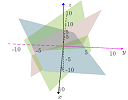



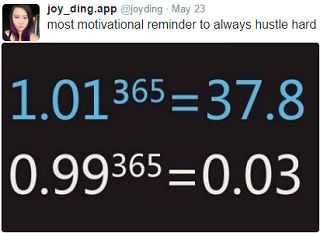
29 Jun 2016 at 12:03 am [Comment permalink]
x = xerophytes = 72,
y = yams = 21,
z = zinnias = 7
x/8 + y + 10*z = 100 (1)
x + y + z = 100 (2)
0 < x < 100, 0 < y < 100, 0 < z < 100
(1), (2):
(7*x)/8 = 9*z or
7*x = 72*z
then
x = 72, z = 7
and
y = 21
29 Jun 2016 at 12:33 am [Comment permalink]
I'm sorry, Dave. I'm afraid I can't do that.
Something messed up. :-(